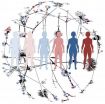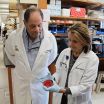(Press-News.org) BOSTON (March 19, 2014) – Experts across academia, industry and government propose a new method for health care providers to get the right treatments to the right patients at the right time. This new approach, A Proposal for Integrated Efficacy-to-Effectiveness (E2E) Clinical Trials, published in Nature Clinical Pharmacology & Therapeutics, recommends a seamless transition from controlled experiments to real-world comparative effectiveness trials. This continuum will improve the accuracy of treatment selection and better determine how those treatments work on different groups of people.
Efficacy trials are conducted in optimal conditions with patients who have similar characteristics. These trials are typically used to secure regulatory approval for a drug.
Effectiveness trials are conducted in more typical clinical settings, with patients who have varying characteristics. These trials are designed to determine whether treatment effects identified in efficacy trials carry over to more typical uses of drugs in practice.
Currently, efficacy and effectiveness trials are conducted separately, and effectiveness trials may occur years later or not at all. In the E2E model, an effectiveness trial starts immediately after the efficacy trial is completed (or as soon as possible, depending upon a predetermined approval process). Data derived from the efficacy trial can be used to formulate questions to investigate during the effectiveness trial; data derived from the effectiveness trial can then be used to assist patients and providers in making individual treatment decisions.
Development of the E2E approach was led by Harry P. Selker, MD, MSPH of Tufts Clinical and Translational Science Institute (CTSI) and Tufts Medical Center's Institute for Clinical Research and Health Policy Studies (ICRHPS), with assistance from Aaron Kirby, MSc, Tufts CTSI's Manager of Project Administration. The research team includes:
Kenneth A. Oye, PhD, Massachusetts Institute of Technology (MIT)
Hans-Georg Eichler, MD, MSc, European Medicines Agency
Norman L. Stockbridge, MD, PhD, US Food and Drug Administration, Center for Drug Evaluation and Research
Cyrus R. Mehta, PhD, Harvard School of Public Health
Kenneth I. Kaitin, PhD, Tufts Center for the Study of Drug Development
Newell McElwee, PharmD, MSPH, Merck & Co.
Peter K. Honig, MD, MPH, AstraZeneca
John K. Erban, MD, Tufts Cancer Center
Ralph B. D'Agostino, PhD, Boston University; Harvard Clinical Research Institute
"The E2E approach represents a fundamental shift in a drug development model that has remained basically unchanged for over fifty years," suggests Kenneth I. Kaitin, PhD, director of the Tufts Center for the Study of Drug Development and research professor at Tufts University School of Medicine. "Although adoption of the approach is not without its challenges, there are likely to be many winners: industry, who will gain better understanding of a drug's utility, enabling differentiation from competitors; regulators, who will have greater understanding of the drug's safe and effective use in heterogeneous populations; payers, who will be able to make more informed reimbursement and coverage decisions; and of course physicians and patients, who will benefit from real-world data on the benefits and risks of new medicines."
"There is growing realization that the difference between efficacy and effectiveness is not just a challenge for drug regulation, but also an underutilised learning opportunity," says Hans-Georg Eichler, MD, MSc, of European Medicines Agency, "the heterogeneity of real-life treatment populations may help identify non-responders or non-tolerators, and such insights may not be gained from the rather homogenous clinical trial populations. Realizing this learning opportunity will require pre-planned and cost-effective studies: the E2E trial may be exactly what's needed."
The authors hope practitioners will consider the E2E model for future trials.
INFORMATION:
The E2E investigation and report were supported by the National Institutes of Health National Center for Research Resources (under award number UL1RR025752) and National Center for Advancing Translational Sciences (under award number UL1TR000073). The content is solely the responsibility of the authors and does not necessarily represent the official views of the European Medicines Agency, the US Food and Drug Administration, or the NIH.
About Tufts Clinical and Translational Science Institute (CTSI)
Tufts CTSI, a National Institutes of Health (NIH)-supported partnership among all the schools and hospitals of Tufts University, Northeastern University, Brandeis University, RAND, and healthcare industry and community organizations, was established in August 2008. Its purpose is to accelerate the translation of laboratory and medical research into clinical use, widespread medical practice, and into improved healthcare delivery and health policy. It connects people to research resources, consultation, and education, and fosters collaboration with scholars of all disciplines and with community members, with the ultimate goal of improving the health of the public. Tufts CTSI is currently funded by the NIH National Center for Advancing Translational Sciences, award number UL1TR001064.
Multidisciplinary research team led by Tufts CTSI proposes new model for clinical trials
Efficacy-to-Effectiveness design may improve treatment selection accuracy
2014-03-19
ELSE PRESS RELEASES FROM THIS DATE:
Lied-to children more likely to cheat and lie
2014-03-19
People lie – we know this. People lie to kids – we know this, too. But what happens next? Do children who've been lied to lie more themselves?
Surprisingly, the question had not been asked experimentally until Chelsea Hays, then an undergraduate student in psychology at the University of California, San Diego, approached professor Leslie Carver with it. Now the pair have a paper out in Developmental Science, suggesting that adult dishonesty does make a difference, and not in a good way.
"As far as we know," said Carver, associate professor of psychology and human development ...
Small step towards growing tissue in the lab
2014-03-19
University of Adelaide mathematicians have devised a method for identifying how cell clusters have formed by analysing an image of the cluster.
Published in the Journal of Theoretical Biology, their mathematical modelling tool will be useful in helping biologists and tissue engineers to move towards growing human tissue such as liver in the laboratory.
"When any tissue or organ develops, the cells have to organise themselves into the correct structure," says Dr Edward Green, researcher in the University's School of Mathematical Sciences. "This self-organisation process ...
Ancient DNA shows moa were fine until humans arrived
2014-03-19
A study by Curtin University researchers and colleagues from Denmark and New Zealand strengthens the case for human involvement in the disappearance of New Zealand's iconic megaherbivore, the moa - a distant relative of the Australian Emu.
All nine species of New Zealand moa, the largest weighing up to 250 kilograms, became extinct shortly after Polynesians arrived in the country in the late 13th century.
Researchers have previously suggested, from limited genetic evidence, that huge populations of moa had collapsed before people arrived and hence influences other ...
No-refrigeration, spray vaccine could curb diseases in remote areas
2014-03-19
DALLAS, March 19, 2014 — A new kind of single-dose vaccine that comes in a nasal spray and doesn't require refrigeration could dramatically alter the public health landscape — get more people vaccinated around the world and address the looming threats of emerging and re-emerging diseases. Researchers presented the latest design and testing of these "nanovaccines" at the 247th National Meeting & Exposition of the American Chemical Society (ACS), the world's largest scientific society.
Their talk was one of more than 10,000 presentations at the meeting, being held here ...
Understanding binge eating and obesity
2014-03-19
VIDEO:
In this JoVE video article, a set of methods to measure food-related motivation and values are described in JoVE's peer-reviewed video article format.
Click here for more information.
March 19, 2014 —Researchers at the University of Cambridge have developed a novel method for evaluating the treatment of obesity-related food behavior. In an effort to further scientific understanding of the underlying problem, they have published the first peer-reviewed video of their technique ...
101 liver cancer drug candidates pave the way to personalized medicine
2014-03-19
The heart disease drug perhexiline is one of 101 compounds predicted to prevent cancer growth in most patients suffering from our most common liver cancer, HCC. This is an outcome from a novel simulation-based approach using personal sets of proteins of six HCC patients.
"This is the first time personalized models have been used to find and evaluate new potential drugs," says Professor Jens Nielsen at Chalmers University of Technology.
--
Our most common liver cancer, Hepatocellular carcinoma, HCC, causes more than half a million deaths worldwide every year. If the ...
Gut bacteria can cause life-threatening infections in preterm babies
2014-03-19
Babies born prematurely are surviving in increasing numbers. But many withstand complications of early birth only to suffer late-onset sepsis — life-threatening bloodstream infections that strike after infants reach 72 hours of age.
While early-onset sepsis often is caused by pathogens acquired from the amniotic sac or birth canal, the causes of late-onset sepsis have been far less clear.
But now, researchers at Washington University School of Medicine in St. Louis have discovered that preterm babies' guts harbor infectious microbes that can cause late-onset sepsis.
The ...
Drinking alcohol several times a week increases the risk of stroke mortality
2014-03-19
Consuming alcohol more frequently than twice a week increases the risk of stroke mortality in men, according to a study carried out at the University of Eastern Finland. The results show that the effects of alcohol are not limited to the amount consumed, but also the frequency of drinking matters. The results were published in Acta Neurologica Scandinavica on 8 March.
Excessive consumption of alcohol is associated with a variety of different diseases. The relationship between alcohol consumption and ischaemic stroke shows a J curve pattern, which means that in people ...
GPS also helps to analyze global water resources
2014-03-19
This news release is available in German. FRANKFURT. WaterGAP (Water Global Assessment and Prognosis) is a hydrological model used to model water shortage, groundwater depletion, and floods and droughts (e.g. as impacted by climate change) over the land area of the globe. The Frankfurt hydrologist Prof. Petra Döll has examined how good a fit this model provides, using GPS observations and data from the GRACE satellite, which measures the gravitational field of the Earth. The study, published in the current issue of the scientific journal Surveys in Geophysics indicates ...
Rewrite the textbooks on water's surface tension
2014-03-19
Researchers from the University of Melbourne and University of Sydney are confident their new reaserach results will make significant differences to the calculations of surface tension of water used by the next generation of atmospheric scientists, biophysicists and engineers of technology like inkjet printers.
These latest investigations have clinched a long-standing controversy amongst the physical Chemistry community; the air-water interface is negatively charged by the adsorption of hydroxide ions.
Prof Angus Gray-Weale from the Chemistry, Department of Chemistry ...
LAST 30 PRESS RELEASES:
Making lighter work of calculating fluid and heat flow
Normalizing blood sugar can halve heart attack risk
Lowering blood sugar cuts heart attack risk in people with prediabetes
Study links genetic variants to risk of blinding eye disease in premature infants
Non-opioid ‘pain sponge’ therapy halts cartilage degeneration and relieves chronic pain
AI can pick up cultural values by mimicking how kids learn
China’s ecological redlines offer fast track to 30 x 30 global conservation goal
Invisible indoor threats: emerging household contaminants and their growing risks to human health
Adding antibody treatment to chemo boosts outcomes for children with rare cancer
Germline pathogenic variants among women without a history of breast cancer
Tanning beds triple melanoma risk, potentially causing broad DNA damage
Unique bond identified as key to viral infection speed
Indoor tanning makes youthful skin much older on a genetic level
Mouse model sheds new light on the causes and potential solutions to human GI problems linked to muscular dystrophy
The Journal of Nuclear Medicine ahead-of-print tip sheet: December 12, 2025
Smarter tools for peering into the microscopic world
Applications open for funding to conduct research in the Kinsey Institute archives
Global measure underestimates the severity of food insecurity
Child survivors of critical illness are missing out on timely follow up care
Risk-based vs annual breast cancer screening / the WISDOM randomized clinical trial
University of Toronto launches Electric Vehicle Innovation Ontario to accelerate advanced EV technologies and build Canada’s innovation advantage
Early relapse predicts poor outcomes in aggressive blood cancer
American College of Lifestyle Medicine applauds two CMS models aligned with lifestyle medicine practice and reimbursement
Clinical trial finds cannabis use not a barrier to quitting nicotine vaping
Supplemental nutrition assistance program policies and food insecurity
Switching immune cells to “night mode” could limit damage after a heart attack, study suggests
URI-based Global RIghts Project report spotlights continued troubling trends in worldwide inhumane treatment
Neutrophils are less aggressive at night, explaining why nighttime heart attacks cause less damage than daytime events
Menopausal hormone therapy may not pose breast cancer risk for women with BRCA mutations
Mobile health tool may improve quality of life for adolescent and young adult breast cancer survivors
[Press-News.org] Multidisciplinary research team led by Tufts CTSI proposes new model for clinical trialsEfficacy-to-Effectiveness design may improve treatment selection accuracy



